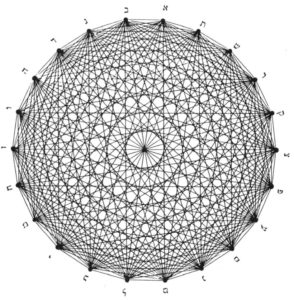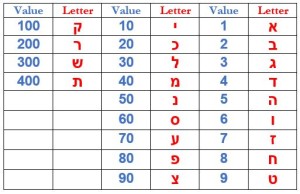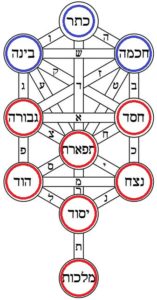
In this week’s parasha, Ha’azinu, Moses cautions the people in his final song to carefully fulfil “all the words of this Torah, for it is not an empty thing for you” (Deuteronomy 32:46-47). The Ba’al HaTurim (Rabbi Yakov ben Asher, 1269-1343) comments here that, on a deeper level, the words “for it is not an empty thing for you” are referring to gematriot, the numerical calculations and mathematical codes embedded in the Torah, that emanate from the divinity and precision of the Hebrew language. The general public often disparages gematria as being unreal or artificial in some way, a soup where anyone can find anything they are looking for. This couldn’t be further from the truth. While some have certainly abused gematria in unnatural ways, there is a legitimate foundation and system to it.
In the same way that the universe itself is entirely mathematical in nature, and everything can be described with numbers, equations, and formulas, the Torah, too, is mathematical in nature and can be described with numbers. (We explored this in great depth in The Encoded Universe shiur.) The Torah itself alludes to this frequently, giving long lists of numbers that might appear meaningless: Why record the precise lifespans of all the ancient figures in Genesis, and split them up into strange chunks of digits, instead of just giving one number. (For instance, Sarah’s life is given as 100 years, and 20 years, and 7 years—why not just say 127 years?) Why provide lengthy accountings of the exact numbers and weights of every item in the Mishkan? Why have so many different censuses? The Torah is telling us to pay attention to numbers. In fact, the Talmud (Kiddushin 30a) states that the first sages of Judaism were referred to as Sofrim, “Counters”, because they analyzed the Torah numerically.

Basic Gematria Chart
And so, the Ba’al HaTurim comments on the words “for it is not an empty thing for you” to teach that gematriot are truly not an empty thing, so don’t be so quick to brush it off. He proves it beautifully, and appropriately, by demonstrating that the numerical value of the phrase “for it is not an empty thing for you” (כִּי לֹא-דָבָר רֵק הוּא מִכֶּם) is 679, the value of gematriot (גימטריות)! With numerical precision, the Torah highlights that gematriot are not an empty matter. As such, let us present just a handful of examples of the Torah’s mathematical exactness.
Mathematics of Parenthood
We will start with some simple math, and work our way up. The Torah begins by telling us about the first couple, Adam and Eve. They are the parents of us all. The word for a father in Hebrew is av (אב), with a value of 3; the word for a mother is em (אם), with a value of 41. Together, a father and mother produce a child, yeled (ילד), with a value of 44. This is the same value as that of blood (דם), for the parents only provide the physical body of the child. It is God that adds the divine, unique soul, represented by the singular letter aleph, bringing the total value to 45, which is the value of adam (אדם), a complete human. The aleph represents God for a number of reasons, including that it’s value is one, and the literal meaning of aleph is “chief” or “master”. More profoundly, the ancient Sefer HaTemunah teaches that an aleph is composed of a vav and two yuds, with a value of 26, equal to God’s Ineffable Name (יהוה).

The letter aleph is made up of two yuds and a vav. Each yud has a value of 10, while vav has a value of 6, making a total of 26.
From a scientific standpoint, too, it is significant that “father” is 3 and “mother” is 41. The man’s role in the initial production of the child is only to deliver the seed. The woman’s role is to “germinate” the seed and form it into an actual person. For the man, therefore, the job essentially ends when the embryo is conceived. Scientifically speaking, it can take up to 3 days for sperm to meet egg after copulation. At this point, the man is a “father”. The woman then takes over. We know today that it is around day 40 of gestation that the first neurons start firing in the developing baby. Our consciousness is generated by our neurons, which begins to take shape around day 40. (By this point, the first pre-heart cells start contracting, too.) Our Sages amazingly knew this, and stated that before day 40, the fetus is comparable to “water”, and afterwards it already takes on the status of a living being (Yevamot 69b). At this point, the woman can be considered a “mother”. Again, we see the mathematical precision of “mother” in Hebrew having a value of 41, the day from which a pregnant woman is considered a mother.
Now, the first parents were Adam and Eve, and their story starts off the entire Tanakh. Rav Yitzchak Ginsburgh beautifully points out that the entire narrative of the Tanakh spans a total of 64 generations and, incredibly, the sum of Adam (45) and Eve (19) is 64! Of those 64 generations, God gave the Torah to the 26th generation (of course). From the first proto-Jew, Abraham, to the birth of David—who finally unified all of Israel, established Jerusalem as the capital, and set up the eternal dynasty—there were 14 generations. This is the value of “David” (דוד)!
Torah & Mitzvah Numbers
Abraham was unique in that he was the first person to introduce the concept of positive mitzvot in the service of God. Fittingly, the Torah has a total of 248 positive mitzvot, the value of “Abraham” (אברהם). These 248 correspond to the major bones and organs of the body. The Torah also has 365 negative mitzvot (“don’t do”) that correspond to the major nerves and sinews, as well as to the 365 days of the year. When it comes to positive mitzvot, they are meant to bind us to God. The negative, on the other hand, is to separate us from evil. The realm of evil is represented by the Satan (השטן), the value of whom is 364 (see Nedarim 32b). This is because Satan works to confound people every day of the year—except Yom Kippur. On that day, he rests, and so Israel can properly seek atonement. Over the course of the year, the fulfilment of the 365 negative mitzvot are a shield against Satan.
It was Moses that brought down the entire Torah, with all of its 613 mitzvot (the 248 positive, plus the 365 negative). Appropriately, the value of Moshe Rabbeinu (משה רבינו) is 613. The Ba’al HaTurim points out that when God “saw the light” at the start of Creation (Genesis 1:4), He saw the light of the Torah and its 613 mitzvot, which is why the value of “the light” (את האור) is 613! In addition to the 613 mitzvot in the Torah for Jews, there are an additional 7 “Noahide laws” for the non-Jewish world. Altogether, the Torah contains 620 mitzvot. The Ba’al HaTurim reveals (on Exodus 20:13) that the entire text of the Ten Commandments contains 620 letters, for in those ten proclamations made at Sinai are included all the mitzvot of the Torah. This is also the value of God’s “Crown”, Keter (כתר), for one who fulfills the Torah is likened to one who “crowns” God. One who fails to fulfil the Torah, on the other hand, will be cut off from God, karet (כרת) in the Torah’s language, also with a value of 620.

Recall that in Kabbalah, Keter is the first and highest of the Sefirot. The mystics teach that out of Keter emerge 620 “pillars of light”. The second Sefirah, Chokhmah, contains “32 Paths”, while the third, Binah, has “50 Gates”. Altogether, the inner aspects of the first three upper Sefirot (the mochin, in blue on the diagram at right) add up to 702. This is the value of “Shabbat” (שבת), for it is on Shabbat that we receive an additional soul and are able to perceive the highest levels of reality. (In 702 itself we see an allusion to the fact that on the seventh day we receive a second soul.)
While we are on the topic of Shabbat, the Vilna Gaon taught a famous set of gematriot using a form of numerology called mispar katan, where a number is reduced to a single digit through successive summation. For example, wine is yayin (יין), with a value of 70, which can be reduced down to 7 by summing its digits (7 + 0 = 7). Challah (חלה) is 43, which also reduces to 7 when summing its digits (4 + 3 = 7). On Shabbat, we start by lighting candles, ner (נר), which is 250, reducing to 7 as well (2 + 5 + 0 = 7). Then we recite kiddush on wine (7), followed by hamotzi on challah (7). The first course is always fish, dag (דג) with a value of 7, followed by a meat course (בשר), with a value of 502, which also reduces to 7. So, every aspect of the seventh day meal reduces to 7!
How Torah Leads to Liberty
The value of “Torah” (תורה) itself is 611, which the Sages explain is because at Sinai the nation heard the first two commandments directly from God (Makkot 23b). The remaining eight they heard through the voice of Moses. How do we know? In the Ten Commandments passage, the first two are phrased in the first person (“I am the Lord, your God…”) meaning that God was speaking. The remaining eight, however, are phrased in the third person (“Don’t take the Name of the Lord, your God, in vain…”) meaning that Moses was speaking, about God. So, God relayed the first two commandments, and the remaining 611 were taught by Moses, hence the value of “Torah” being 611.
The Torah (611) was the document through which was forged the covenant, brit (ברית, 612) between God and Israel, allowing us to fulfill the 613 precepts, which is how we attain true liberty, herut (חרות, 614). As our Sages taught, when the Torah tells us that the Ten Commandments were engraved on stone tablets, we should read the word not as “engraved” (harut), but as “liberty” (herut). Meanwhile, the covenant is sealed specifically with the act of circumcision, itself called brit (ברית, 612), for that one mitzvah opens the door to the other 612. Meanwhile, the Ba’al haTurim notes (on Leviticus 25:36) that one of the most egregious sins is charging your fellow interest, ribit (רבית), also 612 because it is akin to transgressing all the other 612 mitzvot of the Torah.
God, Moses, and the Cosmos
When God declared that man’s lifespan would be capped at 120 (Genesis 6:3), the Sages teach that this actually refers specifically to Moses, who lived 120 years. We know this because people continued to live past 120 for centuries after that statement in Genesis, so it could not have referred to everyone in general. The proof is in the value of the word b’shagam (בשגם) in that verse, which has a value of 345, equal to Moshe (משה). The hidden meaning here is that the sins of that generation would not find rectification until the arrival of Moses and the Torah. Now, why was Moses’ life capped at 120? What was his fatal flaw? The ancient Sefer HaPeliyah reminds us that it was because Moses struck the rock for water, mayim min haselah (מים מן הסלע), a phrase that also has a value of 345!
The Arizal taught, even more profoundly, that Moses’ name is 345 because he contained 345 spiritual sparks. Of these 345, the first 37 came from Abel (הבל), whose value is 37. The remaining 308 came from Cain, who reincarnated in Korach (קרח), whose value is 308. Moses rectified both, a total of 345 (see Sha’ar HaPesukim on Korach). At the same time, 345 is the value of one of the key names of God, El Shaddai (אל שדי). Whenever this name appears in the Torah, it is usually in the context of God showering one of His faithful with abundant blessings. This is because El Shaddai means “the Sufficient God” or, literally, “the God Who is Enough”. It represents God’s boundlessness and infinity. In a description reminiscent of the cosmological theory of inflation, the Sages (Chagigah 12a) say God began creating this universe by rapidly expanding it until He came to say dai, “Enough!” hence the name El Shaddai, “the God Who [Said] Enough”.
 In this ever-expanding cosmos, one of the most important numbers is that of π, denoting the mystery of the circle. We envision the expansion of the cosmos itself in circular form. More broadly, the number π is representative of endless cycles, and the infinite nature of the number (whose decimal digits never end) further emphasizes its symbolic eternity. While its decimal digits never end, everyone knows the first three numbers of π being 3.14. These same numbers make up the value of Shaddai (שדי), which is 314, denoting the God Who triggered the vast expansion of this “circular” cosmos. It is worth adding that circles and orbits are at the very core of our universe, whether the orbiting of electrons around the nucleus on the smallest atomic scales (if they could be said to “orbit” at all!) or the orbiting of spinning planets around stars on the largest scales, not to mention stars orbiting around the galaxy.
In this ever-expanding cosmos, one of the most important numbers is that of π, denoting the mystery of the circle. We envision the expansion of the cosmos itself in circular form. More broadly, the number π is representative of endless cycles, and the infinite nature of the number (whose decimal digits never end) further emphasizes its symbolic eternity. While its decimal digits never end, everyone knows the first three numbers of π being 3.14. These same numbers make up the value of Shaddai (שדי), which is 314, denoting the God Who triggered the vast expansion of this “circular” cosmos. It is worth adding that circles and orbits are at the very core of our universe, whether the orbiting of electrons around the nucleus on the smallest atomic scales (if they could be said to “orbit” at all!) or the orbiting of spinning planets around stars on the largest scales, not to mention stars orbiting around the galaxy.
In Kabbalah, this goes even further, for one of the most important mystical names of God happens to be Pi (פא״י)! This name is alluded to in many places, most famously in the words from Psalm 145:16 which we recite regularly: poteach et yadecha (פּוֹתֵ֥חַ אֶת־יָדֶ֑ךָ), that God “opens His hands” and satiates all living things. Again, it is indicative of the infinite abundance that God bestows upon His creations in this cosmos that He built. The value of פא״י is 91, the same as the Octagrammaton (יאהדונהי), the fusion of God’s Ineffable Name with His Effable Name, the way He is referred to in this world, Adonai. This is to indicate God’s infinite abundance flooding into this lower world from Above. It is also the value of sukkah (סוכה), because the sukkah is that timeless place where God’s presence can be most felt, in which we are immersed in His “Clouds of Glory”. It is also the value of “Amen” (אמן), which has the power to open up the Heavens when pronounced with kavanah. It is the value of “angel”, malakh (מלאך), those divine emissaries who are able to travel freely between realms, and traverse the vastness of the universe “6000 parasangs in one instant”.
It is on Yom Kippur that we are likened to angels, and even mimic them in proclaiming Baruch Shem Kevod out loud, whereas on other days we recite it in an undertone. On Yom Kippur, we demonstrate our ability to subdue and control our physical nature, to transcend the body, and to purify and elevate the soul. It is only once we have done so, once we have transcended the body and purified the soul on Yom Kippur, that we are able to enter the Sukkah just days later, and truly bask in God’s eternity.
Gmar Chatima Tova and Chag Sameach!
